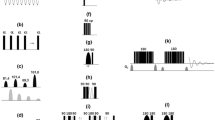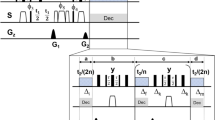Abstract
Water suppression in biological NMR is frequently made inefficient by the presence of faraway water that is located near the edges of the RF coil and experiences significantly reduced RF field. WET180 (WET with 180° pulse-toggling) is proposed to cancel the faraway water contribution to the residual solvent signal. The pulse sequence incorporates a modification of the last WET selective pulse to accommodate insertion of a toggled 180° inversion pulse so that the original WET selective pulse angles are effectively preserved. Compared with existing WET methods, WET180 has the advantages of easy implementation, improved residual water suppression, clean spectral phase properties, and good signal intensity retention. WET180 is expected to be most useful in observing resonances close to water in samples containing biological molecules. In addition, the principle of WET180 can be applied in multidimensional experiments to improve residual water suppression and reduce artifacts around water.




Similar content being viewed by others
References
Bax A (1985) A spatially selective composite 90° radiofrequency pulse. J Magn Reson 65:142–145
Chen Y, Zhang F, Brüschweiler R (2007) Residual water suppression by indirect covariance NMR. Magn Reson Chem 45:925–928
Hwang T-L, Shaka AJ (1995) Water suppression that works. Excitation sculpting using arbitrary wave forms and pulsed field gradients. J Magn Reson A 112:275–279
Marion D, Ikura M, Bax A (1989) Improved solvent suppression in one- and two-dimensional NMR spectra by convolution of time domain data. J Magn Reson 84:425–430
Mescher M, Tannus A, Johnson MO, Garwood M (1996) Solvent suppression using selective echo dephasing. J Magn Reson A 123:226–229
Mo H, Raftery D (2008) Pre-SAT180, a simple and effective method for residual water suppression. J Magn Reson 190:1–6
Neuhaus D, Ismail IM, Chung C-W (1996) “FLIPSY”—a new solvent-suppression sequence for nonexchanging solutes offering improved integral accuracy relative to 1D NOESY. J Magn Reson A 118:256–263
Nguyen BD, Meng X, Donovan KJ, Shaka AJ (2007) SOGGY: solvent-optimized double gradient spectroscopy for water suppression. A comparison with some existing techniques. J Magn Reson 184:263–274
Ogg RJ, Kingsley PB, Taylor JS (1994) WET, a T1- and B1-insensitive water-suppression method for in vivo localized 1H NMR Spectroscopy. J Magn Reson B 104:1–10
Piotto M, Saudek V, Sklenar V (1992) Gradient-tailored excitation for single-quantum NMR spectroscopy of aqueous solutions. J Biomol NMR 2:661–665
Simpson AJ, Brown SA (2005) Purge NMR: effective and easy solvent suppression. J Magn Reson 175:340–346
Sklenar V, Piotto M, Leppik R, Saudek V (1993) Gradient-tailored water suppression for 1H–15 N HSQC experiments optimized to retain full sensitivity. J Magn Reson A 102:241–245
Smallcombe SH, Patt SL, Keifer PA (1995) WET solvent suppression and its applications to LC NMR and high-resolution NMR spectroscopy. J Magn Reson A 117:295–303
Szántay C (1998) Analysis and implications of transition-band signals in high-resolution NMR. J Magn Reson 135:334–352
Wu PS, Otting G (2005) SWET for secure water suppression on probes with high quality factor. J Biomol NMR 32:243–250
Wu D, Chen AD, Johnson CS (1995) An improved diffusion-ordered spectroscopy experiment incorporating bipolar-gradient pulses. J Magn Reson A 115:260–264
Zhang S, Yang X, Gorenstein DG (2000) Enhanced suppression of residual water in a “270” WET sequence. J Magn Reson 143:382–386
Acknowledgements
The authors thank Peter Howe for helpful suggestions. Partial financial support for one of the authors (DR) is from the NIH Roadmap Initiative on Metabolomics Technology, NIH/NIDDK 3 R21 DK070290-01. DR is a member of Purdue’s Cancer and Oncological Sciences Centers.
Author information
Authors and Affiliations
Corresponding author
Electronic supplementary material
Below is the link to the electronic supplementary material.
Rights and permissions
About this article
Cite this article
Mo, H., Raftery, D. Improved residual water suppression: WET180. J Biomol NMR 41, 105–111 (2008). https://doi.org/10.1007/s10858-008-9246-2
Received:
Accepted:
Published:
Issue Date:
DOI: https://doi.org/10.1007/s10858-008-9246-2




